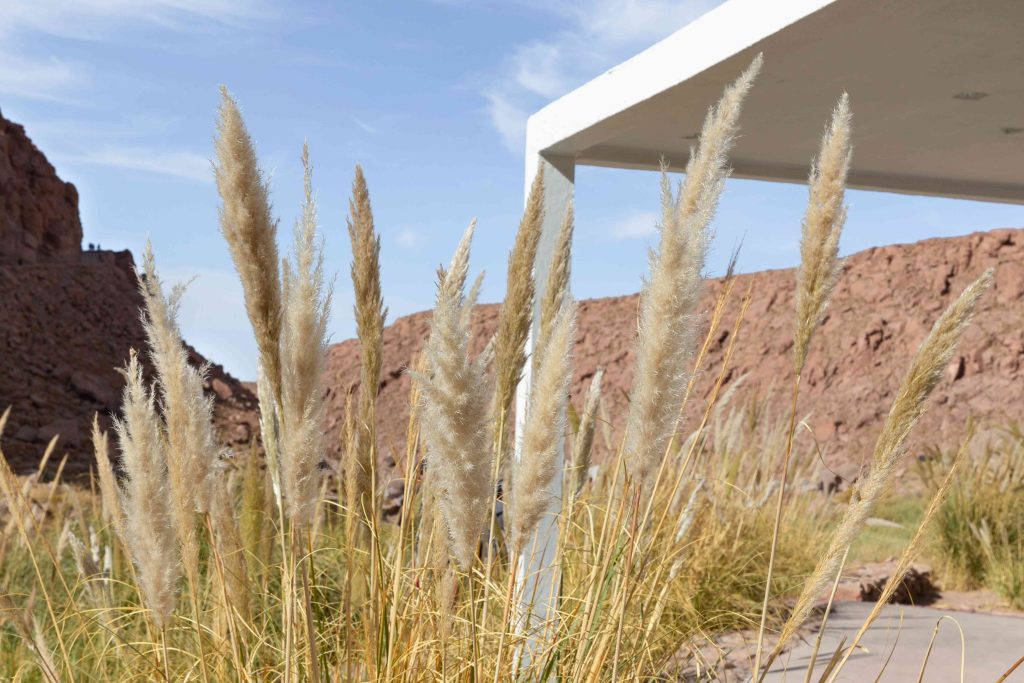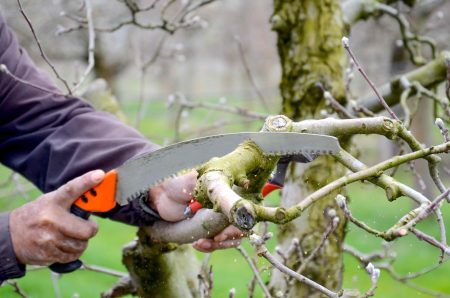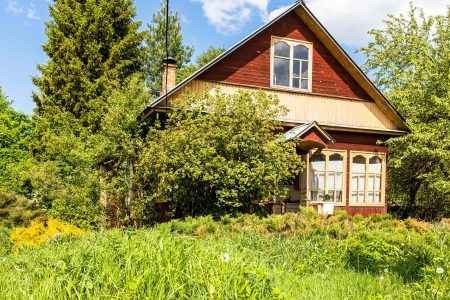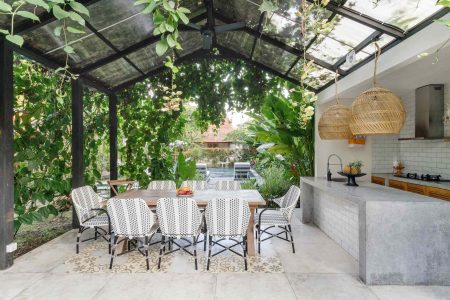Gardeners who want to block a neighbor’s yard or screen a patio without building a structure should consider planting perennial ornamental grasses. Unlike evergreen trees and shrubs, ornamental grasses grow very quickly, usually reaching their mature size in two seasons. Their fast growth rate makes them ideal for privacy hedges because new plants can rapidly fill in any gaps. Moreover, ornamental grasses can be an economical way to achieve privacy on your property. Here are 10 types of ornamental grass that will add privacy and beauty to your landscape.
-
01
of 10Zebra Grass (Miscanthus sinensis ‘Zebrinus’)
Plants with variegated foliage—foliage with a multicolored pattern—are quite popular among gardeners. The foliage of zebra grass can add both visual interest and privacy to your landscape. Under the right conditions, zebra grass can reach its lush 5- to 8-foot potential with a 4- to 6-foot spread. Its clumping habit makes it ideal to grow as a hedge. Water zebra grass regularly until it’s established. Then, it likely will only need watering during an extended dry spell. Moreover, the plant can benefit from a layer of compost each year.
- USDA Hardiness Zones: 5 to 9
- Sun Exposure: Full sun
- Soil Needs: Moist, well-draining, neutral pH
-
02
of 10Hardy Clumping Bamboo (Bambusoideae)
Bamboo is a grass, albeit a very large grass. Although bamboo has a reputation for being invasive in the garden, you can control this by planting the clumping type rather than those that spread by runners. Look for bamboo plants in the Fargesia genus, which are slow-growing and cold hardy. Fargesia robusta can grow up to 17 feet tall and offer great privacy. Water bamboo enough to keep it moderately moist. Fertilizer usually isn’t necessary, but a layer of compost can promote growth. Keep in mind that all bamboo will spread and can be difficult to eradicate once established.
- USDA Hardiness Zones: 5 to 9
- Sun Exposure: Full sun to part shade
- Soil Needs: Rich, moist, well-draining
-
03
of 10Pampas Grass (Cortaderia selloana)
The tender variety of pampas grass, Cortaderia selloana, can be invasive in mild climates. It grows in clumps that can reach 8 to 12 feet tall with a 4- to 6-foot spread for privacy in the garden. This grass is drought tolerant and likely will only need watering during extended dry spells once it’s established. Fertilizer also usually isn’t necessary. You can find a hardier version of this plant in Saccharum ravennae, also known as plume grass or ravenna grass, which grows in zones 5 to 9.
- USDA Hardiness Zones: 8 to 10
- Sun Exposure: Full sun
- Soil Needs: Dry to medium moisture, well-draining
-
04
of 10Feather Reed Grass (Calamagrostis x acutiflora)
Feather reed grass grows in dense clumps of erect, narrow, green leaves that grow about 3 feet long. Pinkish-purple, feathery flower spikes grow above the leaves a couple feet in the summer. It grows to about 5 feet tall with a 2-foot spread. The grass, including the popular ‘Karl Foerster’ cultivar, needs above-average moisture conditions to thrive. Plus, unlike many other kinds of ornamental grass, feather reed grass doesn’t mind heavy clay soil that drains slowly. If you have a rain garden and want a low-maintenance, medium-height screening plant that tolerates some shade, this grass can meet your needs. This grass prefers consistently moist soil, so regular watering often is necessary. Cut back the plant either in the fall or early spring to promote new growth.
- USDA Hardiness Zones: 5 to 9
- Sun Exposure: Full sun
- Soil Needs: Rich, moist, tolerates clay
Continue to 5 of 10 below. -
05
of 10Big Bluestem (Andropogon gerardii)
This North American native plant is a great choice for a privacy screen, growing to about 6 feet tall with a 2- to 3-foot spread. If you had lived in the Midwest 200 years ago, you would have seen large swaths of big bluestem covering most of the prairie with its bluish-green tint in the spring and summer. Neither deer nor drought can faze this tough grass. Plant it in a sunny spot, and it will adapt to a range of soil conditions. Water young plants regularly. Established plants are fairly drought tolerant and don’t usually need watering.
- USDA Hardiness Zones: 4 to 9
- Sun Exposure: Full sun
- Soil Needs: Average, dry to medium moisture, well-draining
-
06
of 10Pink Hair Grass (Muhlenbergia capillaris)
Pink hair grass, or pink muhly grass, is another native beauty that gardeners can grow with little effort. The grass tops out at about 3 to 4 feet, making it perfect for a patio edging that provides some screening for a seating area. Showy pink flowers appear in September and linger to give the garden some winter interest. Pink hair grass tolerates lean soil and dry conditions and can help to ease erosion on slopes. When given consistent moisture, the plant can grow taller. Plus, planting it in a sheltered area in a raised bed can stretch the northern limit of its growing zone.
- USDA Hardiness Zones: 5 to 9
- Sun Exposure: Full sun to part shade
- Soil Needs: Sandy or rocky, dry to medium moisture, well-draining
-
07
of 10Fountain Grass (Pennisetum alopecuroides)
Fountain grass adds privacy and visual interest to a landscape, thanks to its fuzzy catkins (flowering spikes). This plant does best in full sun, though it can tolerate some shade. And its foliage usually remains attractive through winter. It grows in clumps that are around 3 to 5 feet in both height and spread. Some dwarf cultivars exist, so check the plant tag if you want to use it for a privacy screen. Water a young plant once or twice a week until it’s established. You likely won’t have to water mature plants unless you don’t get occasional rain. Fertilizer isn’t necessary, but it can boost growth.
- USDA Hardiness Zones: 6 to 9
- Sun Exposure: Full sun to part shade
- Soil Needs: Average, medium to wet
-
08
of 10Switchgrass (Panicum virgatum)
Another North American native is switchgrass which produces dramatic, swaying feathery pinkish-purple flower plumes and green leaves that turn copper in the fall. It is an adaptable plant that grows in both moist and dry conditions. The grass tends to prefer sandy or clay soil and might flop in soil that is too rich. Thus, you can skip fertilizer unless you have nutrient-deficient soil. The plant grows to around 3 to 6 feet tall with a 2- to 3-foot spread, offering a moderate amount of privacy for a garden. Switchgrass also is an important plant in the ecosystem, providing oil-rich seeds for birds in winter.
- USDA Hardiness Zones: 5 to 9
- Sun Exposure: Full sun to part shade
- Soil Needs: Average, medium to wet
Continue to 9 of 10 below. -
09
of 10New Zealand Flax (Phormium tenax)
New Zealand flax has strap-like leaves which are broader than the thinner and finer fountain grasses, making them ideal for privacy plants. The spiky, sword-like leaves can be found in green, red, copper, or yellow tones and the plant tends to reach heights of over 5 feet and spread about 4 feet wide; some cultivars can grow up to 12 feet high. It’s a most versatile grass that also does well in containers that you can move around for privacy where needed. Plant this perennial in the spring in areas that are sheltered from winds, but otherwise, New Zealand flax is not particularly fussy about its light, soil, or water needs.
- USDA Hardiness Zones: 8 to 10
- Sun Exposure: Full sun to part shade
- Soil Needs: Medium to rich moist, well-drained soil
-
10
of 10Chinese Silver Grass (Miscanthus sinensis ‘Morning Light’)
One of the most popular grasses, Miscanthus sinensis, grows large, feathery, and tall but does just as well in the ground as it does in containers which can be moved around for privacy where needed. Plant Chinese silver grass about 4 feet apart in the ground and they will grow the perfect size to hide fences. Its huge silvery-tinged plumes can grow up to 7 or 8 feet tall—sometimes it can grow as high as 14 feet in a single season—to provide lots of screening. The plant’s airy growth habit has a softening, yet brightening effect in a garden, thanks to variegated green and white striped leaves. Plant in full sun where the soil is fertile and moist. This perennial does best when cut back in the spring before new growth arrives.
- USDA Hardiness Zones: 3 to 9
- Sun Exposure: Full sun
- Soil Needs: Medium-moisture, well-drained soil
-
Are ornamental grasses easy to care for and grow?
Ornamental grasses are hardy, quick growing, affordable, showy, and easy to maintain.
-
Do you need to trim ornamental grass?
To encourage new growth, you should cut back ornamental grass in the late fall for a tidy look through the winter or wait until early spring if you prefer to leave the dried grass for birds and other wildlife to enjoy through the colder months.
-
Do ornamental grasses spread?
Some types of ornamental grasses spread, while others clump. Some kinds both clump and spread. Know what the ornamental grass you’ve chosen does, so you allocate the proper space for it in your yard area and avoid planting an invasive species.
Read the full article here









